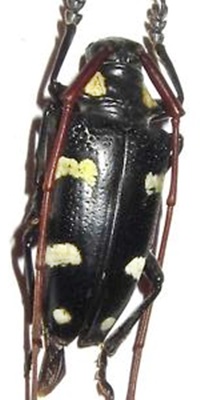| T O P I C R E V I E W |
| BillTyson |
Posted - 14/03/2015 : 14:57:15

30.43 KB
I've seen this called Cereopsius affinis.
It looks like a lightly marked C. luctor but I have never seen a confirmed affinis.
Anyone have some thoughts on this one? |
| 6 L A T E S T R E P L I E S (Newest First) |
| BillTyson |
Posted - 16/03/2015 : 04:10:20
Francesco: I will check all my specimens for the characters you list. I have sexmaculatus from Palawan which extends its range into the Philippines. thanks for the info. |
| Francesco |
Posted - 15/03/2015 : 22:32:17
The apical spot is well present in C. cabigasi!
According to the descriptor, C. cabigasi differs from C. luctor in the confluent pronotal spots and in the lacking of the white mesosternal spot. Moreover, the colour of the elytral spots is yellowish (whitish in C. luctor), nearly the same colour of the antennae.
There are some specimens in our Forum. |
| BillTyson |
Posted - 15/03/2015 : 21:48:20
Appreciate all the insight. As usual, something simple has become complex. Without a specimen in hand, I have been using the lack of apical spots to separate cabigasi from luctor. Apparently this is not a good, quick fix, when all you have is a photograph. thanks |
| dryobius |
Posted - 15/03/2015 : 15:49:33
http://www.cerambycoidea.com/forum/topic.asp?TOPIC_ID=19107&SearchTerms=cereopsius
Bill, I don't know if you saw this recent post. C. luctor has a ridge near the humerus which other Cereopsius in the Philippines lack.
I think it is unfortunate that C. cabigasi was described without a thorough study of this genus. It may be a good species... or maybe not. It may have already been described. The maculae on the elytra of Cereopsius vary to some extent in many species. C. sexmaculatus sometimes has just four. Sometimes C. vittipennis is not vittate. |
| BillTyson |
Posted - 14/03/2015 : 20:29:00
My thoughts as well. Keep seeing C. cabigasi being sold with the 6 spots as well. I believe it also only has 4. thanks |
| Francesco |
Posted - 14/03/2015 : 17:20:09
According to the original description, C. affinis should be similar to C. siamensis, which has four elytral spots.
Thus, it is C. luctor. |


